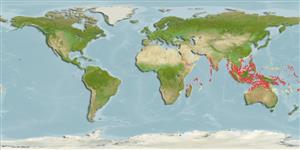Common names from other countries
Environment: milieu / climate zone / depth range / distribution range
Ecologie
marien rifbewoner; diepte 40 - 70 m (Ref. 37816). Tropical; 24°N - 21°S
Indo-West Pacific: off Kosi Bay in South Africa (Ref. 11228) eastward to the Solomon Islands, north to the Philippines, Palau, and the Marshall Islands (Ref. 33390).
Grootte / Gewicht / Leeftijd
Maturity: Lm ? range ? - ? cm
Max length : 21.0 cm TL mannelijk / geslacht onbekend; (Ref. 5591); common length : 16.9 cm SL mannelijk / geslacht onbekend; (Ref. 37816)
Dorsale stekels (totaal) : 10; Dorsale zachte stralen (totaal) : 13; Anale stekels: 2; Anale zachte stralen: 12; Wervels: 24. Body pale olive-grey, darker above, belly pale blue; bluish violet band joining eyes across front of snout; lips and cheeks blue; upper 1/3 of pectoral fins bluish white, remainder pale yellow (Ref. 5591). This rare species has the deepest body in the genus and a thicker tail than H. cuniculus and H. starcki (Ref. 37816).
Inhabits sandy areas at bases of reefs (Ref. 9710). A rare species that schools above huge mounds of rubble that it apparently builds (up to 5.5 m long x 3 m wide over 1 m high). Solitary or in pairs (Ref 90102).
Levenscyclus en paargedrag
Maturities | Voortplanting | Spawnings | Egg(s) | Fecundities | Larven
Displays obligate monogamy where a one-to-one pair is established irrespective of resource abundance (Ref. 52884).
Randall, J.E. and J.K. Dooley, 1974. Revision of the Indo-Pacific branchiostegid fish genus Hoplolatilus, with descriptions of two new species. Copeia 1974(2):457-471. (Ref. 9870)
Status op de Rode Lijst van het IUCN (Ref. 130435)
CITES (Ref. 128078)
Not Evaluated
Gevaar voor de mens
Harmless
Gebruik door de mens
Visserij: commercieel; Aquarium: Commercieel
Tools
Speciale rapporten
Download XML
Internetbronnen
Estimates based on models
Preferred temperature (Ref.
115969): 26 - 28.4, mean 27.4 (based on 253 cells).
Fylogenetische diversiteitsindex (Ref.
82804): PD
50 = 0.5001 [Uniqueness, from 0.5 = low to 2.0 = high].
Bayesian length-weight: a=0.01122 (0.00514 - 0.02450), b=3.04 (2.87 - 3.21), in cm Total Length, based on all LWR estimates for this body shape (Ref.
93245).
Trofisch niveau (Ref.
69278): 3.5 ±0.5 se; based on size and trophs of closest relatives
Fishing Vulnerability (Ref.
59153): Low vulnerability (11 of 100).
